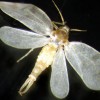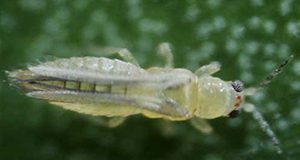Silverleaf whitefly is one of the most notorious invasive arthropods worldwide. It feeds on more than 900 plant species and vectors over 100 plant-damaging viruses. This 10-page fact sheet written by Vivek Kumar, Cristi Palmer, Cindy L. McKenzie, and Lance Osborne and published by the Department of Entomology and Nematology provides management recommendations, strategies for detection and scouting, and advice about control measures for this pernicious pest.
http://edis.ifas.ufl.edu/in1171
Tag: Cindy L. Mckenzie
Thrips Management Program for Horticultural Crops
Among the 5,500 (or more) well-described species of thrips worldwide, nearly 1% are known as economically important pests. Because these tiny pests can feed on multiple plants, their damage potential to nursery and greenhouse production is immense: thrips inflict millions of dollars loss every year. Thrips hide easily in tiny spaces, reproduce rapidly, and can survive in lots of climates. And they are invisibly small! Thrips infestations present a huge problem in the regional and international trade of plant materials and products, due to the quarantine risks and damage associated with several species in the order.
This 7-page fact sheet written by Vivek Kumar, Garima Kakkar, Cristi Palmer, Cindy L. McKenzie, and Lance S. Osborne and published by the UF Department of Entomology and Nematology presents a program to manage important thrips pests, including western flower thrips (Frankliniella occidentalis), chilli thrips (Scirtothrips dorsalis), weeping fig thrips (Gynaikothrips uzeli), gladiolus thrips (Thrips simplex), and privet thrips (Dendrothrips ornatus) known to damage several horticultural crops of economic importance in the United States. The publication will help growers take appropriate measures to minimize economic damage.
http://edis.ifas.ufl.edu/in1145
Rugose spiraling whitefly Aleurodicus rugioperculatus Martin (Hemiptera: Aleyrodidae)
 A new addition on the list of whitefly species found in Florida, Aleurodicus rugioperculatus Martin, was originally called the gumbo limbo spiraling whitefly, but is now named the rugose spiraling whitefly. Being a fairly new species to science – identified less than a decade ago, not much information is available about this pest. It is an introduced pest, endemic to Central America, and was reported for the first time in Florida from Miami-Dade County in 2009. Since then it has become an escalating problem for homeowners, landscapers, businesses, and governmental officials throughout the southern coastal counties of Florida. Feeding by this pest not only causes stress to its host plant, but the excessive production of wax and honeydew creates an enormous nuisance in infested areas. The presence of honeydew results in the growth of fungi called sooty mold, which then turns everything in the vicinity covered with honeydew black with mold. This 5-page fact sheet was written by Vivek Kumar, Cindy L. McKenzie, Catharine Mannion, Ian Stocks, Trevor Smith, and Lance S. Osborne, and published by the UF Department of Entomology and Nematology, October 2013.
A new addition on the list of whitefly species found in Florida, Aleurodicus rugioperculatus Martin, was originally called the gumbo limbo spiraling whitefly, but is now named the rugose spiraling whitefly. Being a fairly new species to science – identified less than a decade ago, not much information is available about this pest. It is an introduced pest, endemic to Central America, and was reported for the first time in Florida from Miami-Dade County in 2009. Since then it has become an escalating problem for homeowners, landscapers, businesses, and governmental officials throughout the southern coastal counties of Florida. Feeding by this pest not only causes stress to its host plant, but the excessive production of wax and honeydew creates an enormous nuisance in infested areas. The presence of honeydew results in the growth of fungi called sooty mold, which then turns everything in the vicinity covered with honeydew black with mold. This 5-page fact sheet was written by Vivek Kumar, Cindy L. McKenzie, Catharine Mannion, Ian Stocks, Trevor Smith, and Lance S. Osborne, and published by the UF Department of Entomology and Nematology, October 2013.
http://edis.ifas.ufl.edu/in1015

